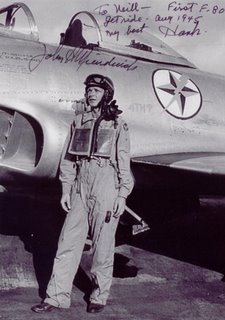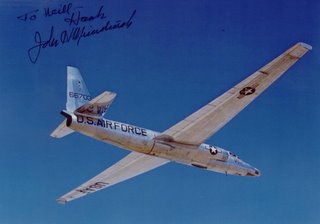


John Henry "Hank" Meierdierck was born in Newark, New Jersey in 1921. His parents spent 11 years in the area. At age eleven, Hank's family moved to Chestertown in upstate New York. Hank rode a bus to school nine miles away.
Tragedy struck when he was 12 when the house caught on fire. He, his father and 3 brothers escaped out the second story window into the snow. The family moved back to Newark. Hank worked delivering papers and in several grocery stores during his high school years. He never had a chance to attend college until much later. At age 42 he received a degree from the University of Maryland.
Hank worked in a shipyard as an accountant and as a mail runner to New York. With the outbreak of World War II, Hank signed up for cadets and was commissioned a Second Lieutenant "fighter pilot" in July 1943. He was assigned to various bases flying P-39, P-40, P-47, etc. and went to France in 1944 where he flew a F-6d and a camera-mounted P-51D. He flew 13 tactical reconnaissance missions over Germany during WWII.
Returning to the United States, in 1945 Hank flew his first jet, a P-80 in the 4th Fighter Group at Andrews Field. Assigned to Panama, he flew reconnaissance missions in a RF-80. Caught up in the post WWII RIF, he enlisted as a Master Sergeant and transferred to March AFB in California. Three months later he was recalled as a First Lieutenant for pilot duty.
Hank spent several years in the 31st and 508th fighter wings in Albany, Georgia. A period after he was one of the pioneers in air to air refueling using the Probe and Droque system in a T-33 and F-80 tiptanks and later with the F-84 . He performed mission planning and flew the F-84G over the North Atlantic, Central Atlantic, and the Pacific oceans. From duties as Air Force program manager for celestial navigation for fighters, in June 1954 he received orders to report to March AFB where he commenced his U-2 experience at Area 51.
At the Area, as a experimental test pilot ,Hanks duties were to integrate in the U-2 test phase with the LAC Test pilots,determine the tactical use of the aircraft, including navigation,cameras,targets,mission,pilot survival and train the three detachments of pilots for the Central Intelligence Agency.
Upon completion of this assignment, Hank spent some time in the UK and ended up serving as Director of Operation for the 414th Fighter Group flying F-101B interceptors at Oxnard AFB, California. Three years later he was visiting the Pentagon and found he was being considered for another "black" assignment. The assignment turned out to be with the Central Intelligence Agency headquarters as Director of Operations for the OXCART program [Yf12A and A12 airplanes] at Area 51. Hank flew the YF-12A once while at the Area. When the OXCART program ended, he remained with the OSA for another program assignment as Program manager and unit commander of the 4027th Squadron at Area 51. He and Millie moved to Las Vegas.
Hank's second tour at the Area was as Commander and program Director for Project Aquiline (early forerunner of the Predator). At Hank's suggestion, this program was aborted. Hank retired in Las Vegas and spent many years fishing and trailering to Canada, Mexico, and wherever the Bass or game fish were plentiful.